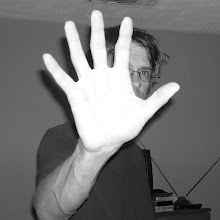There's a wonderful essay about Williams' evolution as an artist at The Savage Critic(s). I highly recommend reading it. There, Jog, the author of the piece, nicely describes Williams' current work with Batwoman:
"Williams' art tells a story in tandem with but also independent of [Greg] Rucka's words. It's free to run ahead of the plot, giving away secrets or even undercutting the dialogue for a deeper total effect. To say that Williams' art is merely good-looking or well-designed is to deny how truly unique it is, not so much inhabiting narrative space as invading it[.]"I couldn't agree more. I love this art and I've often wondered, while reading Detective Comics, if original pieces would ever be available for sale. Turns out, Williams sells many of pages on his blog.
So, I couldn't resist. After raising a little money through eBay, I purchased one of my favorite double page spreads, the "Yin/Yang" image of Batwoman versus her arch nemesis, Alice, from Detective Comics #857 (click to enlarge):
There's a wonderful symmetry to this piece, beyond the contrasting figures of Batwoman on top and Alice on bottom. Notice, first, how the two capes extend to create three unique panels on each side of the picture. Batwoman's cape creates jagged, sharp panels; Alice's produces soft, dreamy ones. The shapes of these panels have, throughout earlier issues of the story, reflected the natures of both women: Batwoman is a character of action and discipline; Alice is a figure of violence and insanity. Here, on one page, they are presented in direct contrast to one another.
The symmetry of the panels extends to their contents, as well. Alice dominates on the left (in Batwoman's panels). She points her gun at an alarmed Batwoman (panel 1). She shoots until her bullets are gone (panel 2). Under fire, Batwoman crouches to protect herself (panel 3). Then, as the flow of the story moves to the right, the action shifts. Now, Batwoman dominates (in Alice's panels): She prepares to attack while Alice turns to flee (panel 4). She fires her gun (here, it is not a weapon of death, but a tool to attempt capture) (panel 5). Finally, she pursues a fleeing Alice (panel 6).
Each panel on the spread is distinctly complemented by one on the opposite side. Beautiful.
I love this page: It represents a significant moment in the Batwoman/Alice arc; a critical piece of a larger whole. And yet it also manages to stand on its own. Yes, there is much that takes place before and after these two pages, but, even without the rest of the story, you can sense the larger narrative condensed here in one single sequence.




Williams isn't doing the art for Detective Comics anymore :(
ReplyDeleteIt's definitely worth checking out some of his other stuff, though, like the arc he did with Grant Morrison on the main Batman title (Issues 667-669, I don't know if the arc had a name but it's in the "Black Glove" trade. He also co-created a series with Alan Moore called Promethea which I've heard good things about but never read.